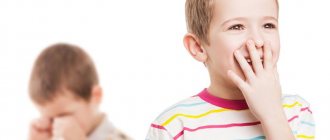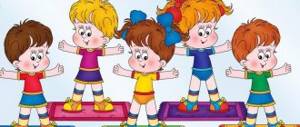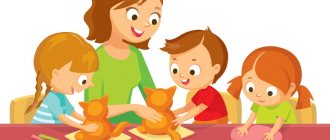Creating psychological comfort in kindergarten groups
Author: Kozhokhina Kristina Sergeevna
Creating psychological comfort in kindergarten groups
1. Problems of psychological health at the present stage.
Children's health is called one of the fundamental values of education. Today it is argued that the main goal of psychological services is to ensure conditions for the psychological health of children of preschool and school age.
Recently, teachers have increasingly had to deal with very distorted behavior of preschoolers. On the one hand, there is extraordinary stiffness and underdevelopment of speech. On the other hand, there is strong aggressiveness and some kind of wild, off-scale demonstrativeness. Such a child cannot answer the simplest question, but at the same time he is not afraid to make faces in front of other adults or crawl under the table. In short, he behaves completely uncontrollably. Patterns of bad behavior attract like a magnet.
The Concept of Preschool Education gives a leading place to solving problems related to the protection and promotion of children's health. But it also says that “if concern for the physical health of the child in one form or another is reflected in all documents regulating the work of the teacher, then the requirement of “the psychological well-being of the child” sounds like a meaningless phrase.
The World Health Organization's definition of health is:
Health is a state of complete physical, mental and social well-being and not merely the absence of disease or infirmity.”
Psychological health includes the ability to adequately respond to external and internal stimuli; general mental comfort, adequate behavior, the ability to manage one’s emotional states, overcome stress, this is mental activity, the need for self-development, to know oneself.
Quite a lot of children need psychocorrection and are characterized by serious psychological distress.
To provide a child with the conditions for a healthy and fulfilling life, an adult is needed. This is an axiom that does not require proof today. We can say that “what is actually human in a person” is always another person. Adults (normally!) provide the child with the presumption of humanity - the right and opportunity to stand on the human path of development.
However, for some children the shadow of “damage” falls at birth. We call them “children with special needs.” To “break the spell” of a child, to help him find the spirit of a full human life, a close Other is needed.
Experts are aware of a widely used but usually extremely vague definition - “significant adult.” In the logic of our reasoning, it becomes necessary to fill it with specific psychological content. A significant adult is a relative and/or close person who has a significant, decisive influence on the conditions of development and lifestyle of the child: parent, guardian, teacher, mentor...
Therefore, the goal of practical psychological work with children in preschool educational institutions is the child’s mental health, and his mental and personal development is a condition, a means of achieving this health.
The term “psychological health” itself is ambiguous; it, first of all, seems to connect two sciences and two areas of practice – medical and psychological. This is based on the understanding that any somatic disorder is in one way or another associated with changes in the mental state.
WHO experts paid particular attention to the fact that it is in childhood that mental health problems have a more direct connection with the environment than in other age periods.
Distinguishing the terms “mental health” and “psychological health”.
If the term “mental health” relates primarily to individual mental processes and mechanisms, then the term “psychological health” refers to the individual as a whole.
If the norm for mental health is the absence of pathology, symptoms that interfere with a person’s adaptation in society, then to determine the norm of psychological health it is important to have certain personal characteristics. And if the concern of medical workers for the most part is getting rid of pathological factors, then the direction of action of teachers goes towards helping the child acquire useful properties that contribute to successful adaptation.
Since psychological health presupposes the presence of a dynamic balance between the child’s personality and the environment, the child’s adaptation to society becomes the key criterion. In our practice, we identify several levels of a child’s psychological health; they are quite conventional, but we need them to organize practical work with children.
The first level includes children who do not need psychological help. They are steadily adapted to any environment, have a reserve for overcoming stressful situations and have an active creative relationship to reality. This ideal image of a child is rarely found in the practice of preschool educational institutions; it expresses the perfect degree of psychological health.
To the second adaptive level we include the majority of relatively “prosperous” children who are generally adapted to society, but based on the results of diagnostic studies, they show individual signs of maladaptation and have increased anxiety. Such children do not have a sufficient reserve of psychological health and need group classes with a preventive and developmental focus. This group is at relative risk, it is quite numerous and represents an average level of psychological health.
To the third low level of psychological health, children are either incapable of harmonious interaction, or show deep dependence on external factors, without mastering the defense mechanism, separating themselves from the traumatic influences of the environment. Dependence on the environment: they do not control the environment, but the environment controls them.
The identified levels allow us to differentiate psychological and pedagogical assistance to children. With children of the first group, it is enough to carry out only developmental work that provides a “zone” of immediate development.
Children of the second group need targeted, psychoprophylactic assistance, using group work.
Children who fall into the third group need serious individual correctional assistance.
By specific work to ensure psychological health, we mean a holistic, systematically organized activity, during which socio-psychological and pedagogical conditions are created for the successful development of the child’s inner world.
In order to ensure the preservation and strengthening of a child’s mental health, we must know its characteristics. It is necessary to have a clear understanding of the level of its development, current and potential opportunities, and needs. To do this, the preschool educational institution systematically monitors the child’s psychological and pedagogical status and the dynamics of his mental development.
Secondly, it is necessary to build and modify the developmental environment in such a way that it is as favorable as possible for the mental development of each child, his inner worldview. We build the educational process according to flexible schemes for timely adjustment, change and transformation depending on the psychological characteristics of those children who entered our educational institution.
Thirdly, it is necessary to help each individual child in solving the problems that he himself has in connection with his environment.
2. Creating psychological comfort in kindergarten in order to preserve and strengthen the psychological health and development of the child’s personality.
In order for our children to grow up as healthy, full-fledged citizens, several conditions are necessary that we, adults, can provide for them. These are: proper nutrition, daily routine, stay in the fresh air, physical activity, hardening procedures and psychological comfort.
Let's consider the last factor - the importance of psychological comfort for the child's health.
Most psychologists believe that the psychological health or ill-health of a child is inextricably linked with the psychological atmosphere, or the climate of the family and the climate in the kindergarten group, and depends on the nature of relationships with adults.
The psychological climate within a group can be defined as a more or less stable emotional mood characteristic of a particular group, which is a consequence of communication with the child.
The psychological climate in a group is not something immutable, given once and for all. It is created by the members of each group, and their efforts determine whether it will be favorable or unfavorable.
The main condition for the normal psychosocial development of a child is a calm and friendly environment created through the constant presence of parents who are attentive to the emotional needs of the child, talk with him, maintain discipline, and carry out the necessary supervision. Why is it so important to maintain the emotional (mental, psychological) health of children?
Questions about psychological comfort and mental health should be addressed primarily to teachers, since most of the time children are in kindergarten. But many may argue that there are objective reasons why it is not possible to fully create psychological comfort in a kindergarten group:
— groups of different ages;
- workload of the teacher in the group;
- unfavorable family situation for the child;
- children with special educational needs.
Yes, that's the reality. But who will help our children if not ourselves?
It is known that as soon as you cross the threshold of a group, you can feel the atmosphere of relaxedness or closedness, calm concentration or anxious tension, sincere fun or gloomy wariness that is present in the group.
The atmosphere in a kindergarten group is determined by:
1) The relationship between the teacher and children;
2) Relationships between the children themselves;
3) Relationships between educators;
4) The relationship between educators and parents.
A good climate in a group occurs when all its members feel free, remain themselves, but at the same time respect the right of others to be themselves. The teacher has a very significant influence on the quality of the group climate. In fact, it is the teacher (and not the children, as we usually think) who creates a certain climate in the group.
The first step that an educator interested in creating a favorable atmosphere in a group must take is to create and analyze the group situation.
Recommendations “Creating conditions for a psychologically comfortable stay of a child in kindergarten”
To create conditions for a psychologically comfortable stay of a child in kindergarten, it is necessary:
— Accept every child as he is.
Remember: there are no bad preschoolers.
— In professional activities, rely on the voluntary help of children, include them in organizational aspects of caring for the premises and area.
- Be an entertainer and participant in children's games and fun.
— In difficult situations for a child, focus on his age and individual characteristics: always be with them, and not do something instead of him.
— Involve parents in the educational process and turn to them for support in cases of non-standard situations.
- Remember: the child does not owe us anything. It is we who must help the child become more independent and responsible.
— Imposing your rules and demands against the will of children is violence, even if your intentions are good.
— There should not be too many prohibitions and strict requirements. This leads to passivity and low self-esteem in students.
— A quiet, shy child also needs your professional help, just like an aggressive one.
Such forms of relationships in which the teacher, with the help of various arguments, convinces the child of the advantages of one or another action have a very good effect on the development of children. In this case, the choice is left to the child. This type of relationship requires an individual approach to the characteristics and current conditions of children. It is this kind of unobtrusive care that children most need and thank the adult for their sincere affection for them.
Thus, the emotional well-being of the child is achieved by creating an atmosphere characterized by mutual trust and respect, open and supportive communication. The main emphasis is on overcoming negative emotional manifestations in children (fear, crying, hysteria, etc.) and resolving conflict situations.
Psychological comfort involves establishing trusting personal contact with each child, maintaining self-confidence in him, nurturing independence and initiative in the communication process. This promotes the unification of children and lays down traditions of interpersonal relationships in the children's team.
A large role in this educational system is given to the family. The family is the first institution in which the foundations of a future personality are laid. Parents and the teaching staff of preschool educational institutions must present uniform, reasonable and understandable requirements to the child. Thus, parents should be informed of the need to maintain a daily routine at home that is close to the kindergarten routine.
Creating emotional and psychological comfort for a child means providing the following conditions that contribute to the implementation of his individual development program:
-give the child the opportunity to be himself;
—correct the manifestation of negative emotions and negative behavioral motives, without violating the characteristics of the personal structure, using methods for this,
accessible and interesting for the child himself;
— provide an opportunity to satisfy the child’s urgent needs for love, respect, play, and physical activity;
— teach the child to understand and accept his own feelings and emotions and those of other people;
—introduce ways of communicating with adults and peers for constructive communication in the “child-child” and “child-adult” systems.
A preschool child is psychologically comfortable if he is healthy, not burdened with internal psychological problems, and can be himself if he is surrounded by pleasant adults and children who accept him for who he is, if the child is engaged in an exciting activity.
3. Pedagogical communication styles as a favorable factor of psychological comfort in the group.
The educational and emotional functions depend on the style of the teacher’s relationship with the child. There are 4 relationship styles: from rejection to love, from lack of control to its presence.
Democratic style.
It is characterized by wide contact with pupils, manifestations of respect for them, the teacher strives to establish emotional contact with the child, and does not suppress with severity and punishment; Positive assessments predominate in interactions with children. Such a teacher feels the need for feedback from children on how they perceive certain forms of joint activity; knows how to admit mistakes made. In his work, such a teacher stimulates mental activity and motivation to achieve cognitive activity. In groups of educators whose communication is characterized by democratic tendencies, optimal conditions are created for the formation of children's relationships and a positive emotional climate of the group.
Authoritarian style.
Relationships are cold. They give orders and expect them to be carried out exactly. Closed to constant communication with children; establish strict requirements and rules and do not allow their discussion; allow children to have only a small degree of independence from them. The child is “inside”, the teacher suppresses the child, controls his entire life. Moreover, teachers resort to authoritarian methods with the best intentions: they are convinced that by breaking children and achieving maximum results from them here and now, they can more quickly achieve their desired goals.
Liberal style
Characterized by lack of initiative, irresponsibility, inconsistency in decisions and actions, and indecisiveness in difficult situations. Such a teacher “forgets” about his previous demands and after a certain time is able to present completely opposite ones. Tends to let things take their course and overestimate the capabilities of children.
Indifferent style
They do not set any restrictions for children; indifferent to them.
Closed for communication; due to being burdened with one’s own problems, there is no energy left to raise children; show indifference to the child’s life.
In life, each of the named styles of pedagogical communication in its “pure” form is rarely encountered. In practice, it is often found that a teacher exhibits a so-called “mixed” style of interaction with children. A mixed style is characterized by the predominance of two styles: authoritarian and democratic or democratic and liberal. The features of authoritarian and liberal styles are rarely combined with each other.
Conclusion.
It is very important to remember and realize that the attitude of adults towards a child affects not only the development of personality, but also the psychological health of children.
A child must grow and be educated in conditions of constant adherence to the principle of pedagogical ecology. The relationship of parents and teachers to a preschooler should be built on acceptance of the child, on pedagogical optimism and trust, on empathy, and respect for his personality.
Knowledge not only about the patterns of formation of a child’s personality, but also about the mental characteristics of children with a weakened psyche will allow teachers not only to properly organize the educational process, but will also help correct some painful mental characteristics, change incorrect attitudes and forms of behavior, and will also make it possible to provide parents with qualified answers to educational questions that interest them.
comments powered by HyperComments
Favorable moral and psychological climate in the classroom.
Without a favorable psychological climate in the classroom, the development of camaraderie and mutual assistance is impossible. A favorable psychological climate contributes to a student’s better assimilation of educational material and the full development of his personality; therefore, the creation of a favorable psychological climate in the classroom is an important component of pedagogical work, since psychologically healthy, creative, self-confident people are of particular value for modern society. Working as a teacher, I try to create a favorable psychological climate in the classroom.
In order to study the psychological climate in the classroom, a survey “Psychological climate in the classroom” was conducted.
The results of the survey are presented in the summary table.
| Poll Options | 4th grade 2016-2017 | 2nd grade 2017-2018 | ||
| "Yes" | "No" | "Yes" | "No" | |
| 1. I go to class in a good mood. | 16 students (80%) | 4 students (20%) | 14 students (78%) | 4 students (22%) |
| 2. I feel comfortable in class. | 17 students (85%) | 3 students (15%) | 16 students (89%) | 2 students (11%) |
| 3. You can calmly ask the teacher for help in class. | 19 students (95%) | 1 students (5%) | 18 students (100%) | — |
| 4. The teacher discusses with us difficult issues encountered in homework. | 20 students (100%) | — | 18 students (100%) | — |
| 5. I have a good relationship with this teacher. | 18 students (90%) | 2 students (10%) | 18 students (100%) | — |
Based on the results presented in the table, we can conclude that the moral and psychological climate in the lessons is favorable, students feel comfortable in the lesson.
Effective organization of educational space
For the implementation of the practical part of the educational program, the availability of material and technical base plays an important role. In connection with the growing role of ICT in the educational process and the need for remote communication between participants in the educational process, a local wired network was installed at the school. Wi-Fi connection works, which allows you to use Internet resources. The class is provided with a set of interactive equipment.
Valeological passport of office No. 206
| Classroom Health Assessment | |
| Coefficient of natural illumination (most distant place 1.75 – 2%) | complies with standards |
| Main light flow | From the left side |
| The presence of light openings in the wall where the board hangs | No |
| Location of benefits | front |
| Optimal orientation of classroom windows | according to standards |
| Hygienic standards compliance with windows | purity |
| Place of flowers in the classroom | behind and left |
| Classroom illumination | according to standards |
| Turning on the lights | separate |
| Illumination of the working surface | norm |
| Classroom occupancy | |
| Classroom area | 58 m2 |
| Classroom uniform | norm |
| Arrangement of desks in the classroom | frontal |
| Login to class | front |
Diagnostic card of the classroom
| Head office | Manager's work experience office | Office operating time | ||||
| Kopysova Marina Leonidovna | 3 g | 800– 1500 | ||||
| Availability: | ||||||
| Rules of conduct and safety precautions | Instructions TB magazine Safety corner | |||||
| Office work plan | available | |||||
| Administrative control over the activities of the cabinet | carried out | |||||
| Monitoring compliance with office requirements | carried out | |||||
| Office decoration | ||||||
| Comfortable working conditions for students and teachers | Aesthetic design | Educational standard materials | Availability of standard meters | Teacher's recommendations for students | ||
| + | + | + | + | + | ||
| Ensuring the activities of the office | ||||||
| Furniture (general condition) | TSO (screen, projector, audio, video, etc.) | Educational and methodological literature, didactic materials, tests, etc. | Materials for students (literature, handouts) | Planning and designing teacher activities | ||
| good | + | + | + | + | ||
Development plan for office No. 206
For 2018-2020
| № | Event | date |
| Continue the production and systematization of handouts in the subjects of music and fine arts as the topics are studied. | During a year. | |
| Update and replenishment of didactic material. | During a year. | |
| Create new presentations on subjects as you study. | During a year. | |
| Purchase of new educational programs and CDs. | During a year. | |
| Replacing the door in the office. | During a year. | |
| Warming the office. | Beginning of the school year | |
| Cabinet renovation. | End of the school year |
The office is materially and technically equipped, which is confirmed by the implementation of the practical part of the educational program.





